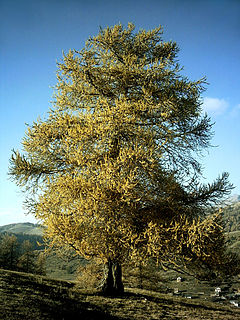Larch
| Larch | |
|---|---|
 |
|
| Larix decidua in autumn | |
| Scientific classification | |
| Kingdom: | Plantae |
| Division: | Pinophyta |
| Class: | Pinopsida |
| Order: | Pinales |
| Family: | Pinaceae |
| Genus: |
Larix Philip Miller |
| Species | |
|
About 10–14; see text |
|
About 10–14; see text
Larches are conifers in the genus Larix, in the family Pinaceae. Growing from 20 to 45 m tall (65 to 147 ft), they are native to much of the cooler temperate northern hemisphere, on lowlands in the north and high on mountains further south. Larches are among the dominant plants in the boreal forests of Siberia and Canada. Although they are conifers, larches are deciduous trees that lose their leaves in the autumn.
Larch shoots are dimorphic, with leaves borne singly on long shoots typically 10–50 centimetres long and bearing several buds, and in dense clusters of 20-50 needles on short shoots only 1–2 mm long with only a single bud. The leaves are needle-like, 2–5 centimetres long, slender (under 1 cm wide). Larches are among the few deciduous conifers, which are mostly evergreen. Other deciduous conifers include the golden larch Pseudolarix amabilis, the dawn redwood Metasequoia glyptostroboides, the Chinese swamp cypress Glyptostrobus pensilis and the bald cypresses in the genus Taxodium.
The female cones of larches are erect, small, 1–9 cm long, green or purple, ripening brown 5–8 months after pollination; in about half the species the bract scales are long and visible, and in the others, short and hidden between the seed scales. Those native to northern regions have small cones (1–3 cm) with short bracts, with more southerly species tending to have longer cones (3–9 cm), often with exserted bracts, with the longest cones and bracts produced by the southernmost species, in the Himalayas.
In the past, the cone bract length was often used to divide the larches into two sections (sect. Larix with short bracts, and sect. Multiserialis with long bracts), but genetic evidence does not support this division, pointing instead to a genetic divide between Old World and New World species, with the cone and bract size being merely adaptations to climatic conditions. More recent genetic studies have proposed three groups within the genus, with a primary division into North American and Eurasian species, and a secondary division of the Eurasian into northern short-bracted species and southern long-bracted species; there is some dispute over the position of Larix sibirica, a short-bracted species which is placed in the short-bracted group by some of the studies and the long-bracted group by others.
...
Wikipedia
